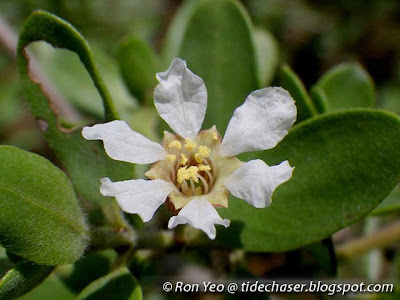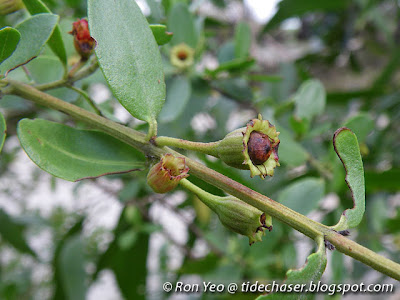The Mentigi (Pemphis acidula) is a locally critically endangered mangrove plant from the family Lythraceae.
The Mentigi is usually found on rocky or sandy areas on the landward side, often above the high tide level. In Singapore, it occurs naturally on some of the southern islands and a few reclaimed beaches, though the ones at Changi and Marina East have died and it is not known if it can still be found on other reclaimed beaches. A few were planted on Pulau Ubin, Tampines Eco Green and HortPark.
The species occur in the form of spreading shrubs, such as the ones above...
...or trees with a main trunk, depending on the habitat.
The simple opposite leaves, covered with fine hair, are the smallest among the local mangrove species - between 4-8mm wide and usually less than 20mm long. The flowers are small (not more than 20mm wide) with six white petals.
The fruits are small about 5mm across, turning reddish brown as they mature.
The wood is very hard and durable, and is used to make hand tools, walking sticks and other hardy wooden artifacts. It was often grown for ornamentation purpose and as a bonsai, due to its pretty flowers and small leaves.
References
- Chong, K. Y., H. T. W. Tan & R. T. Corlett. 2009. A Checklist of the Total Vascular Plant Flora of Singapore: Native, Naturalised and Cultivated Species. Raffles Museum of Biodiversity Research, National University of Singapore. Singapore. 273 pp.
- Giesen, W., S. Wulffraat, M. Zieren & L. Scholten. 2006. Mangrove guidebook for Southeast Asia. RAP Publication 2006/07. FAO Regional Office for Asia and the Pacific & Wetlands International. Bangkok. 769 pp.

No comments:
Post a Comment